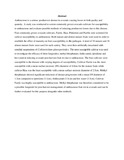Cultivar Reaction To Anthracnose (colletotrichum Gloeosporioides) And Post-harvest Management Of The Disease In Avocado

View/
Date
2011Author
Mutembei, M. M.
Kimenju, J.W.
Narla, R. D
Type
PresentationLanguage
enMetadata
Show full item recordAbstract
Anthracnose is a serious postharvest disease in avocado causing losses in both quality and
quantity. A study was conducted to screen commonly grown avocado cultivars for susceptibility
to anthracnose and evaluate possible methods of reducing postharvest losses due to this disease.
Four commonly grown avocado cultivars, Fuerte, Hass, Pinkerton and Puebla were screened for
cultivar susceptibility to anthracnose. Both mature and almost mature fruits were used in order to
establish the effect of maturity on fruit susceptibility to the pathogen. A total of 18 mature and 18
almost mature fruits were used for each variety. They were then artificially inoculated with
conidial suspensions of Colletotrichum gloeosporioides. The most susceptible cultivar was used
to investigate the efficacy of three fungicides; methyl thiophanate, fenhexamid, iprodione and
hot water in reducing avocado post-harvest fruit rot due to anthracnose. The four cultivars were
susceptible to the disease with varying degrees of susceptibility. Cultivar Fuerte was the most
susceptible with a mean surface necrosis (SN) diameter of 4.0cm for the mature fruits while
cultivar Hass was the least susceptible with a mean surface necrosis diameter of 2.5cm. Methyl
thiophanate showed significant reduction of disease progression with a mean SN diameter of
1.3cm compared to iprodione (3.1cm), fenhexamid (3.3cm) and hot water (3.3cm). Cultivar
Fuerte was highly susceptible to anthracnose. Methyl thiophanate was therefore considered to be
a possible fungicide for post-harvest management of anthracnose fruit rot in avocado and can be
further evaluated for this purpose alongside other methods.
Citation
Mutembei M. M., Kimenju J.W. and Narla R. D (2011). Cultivar Reaction To Anthracnose (colletotrichum Gloeosporioides) And Post-harvest Management Of The Disease In Avocado.. A paper presented at aGRO2011 Biennial Conference at the College of Agriculture and Veterinary Sciences, Upper Kabete Campus, University of Nairobi, on 26 - 28th SeptemberPublisher
University of Nairobi
